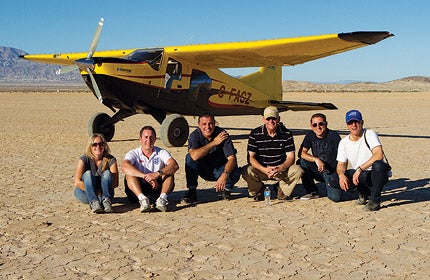From Mountains To Deserts
With massive tundra tires, a welded tubular steel fuselage frame and seating for five, the tailwheel version of Expedition Aircraft’s bushplane lives up to its formidable name: Bigfoot.
 |
With massive tundra tires, a welded tubular steel fuselage frame and seating for five, the tailwheel version of Expedition Aircraft's bushplane lives up to its formidable name: Bigfoot. The new aircraft made the journey from its home in Ontario, Canada, to Southern California for the AOPA Aviation Summit, and we flew it to the most backcountry-like setting we found near the Los Angeles metropolis: the Ocotillo Wells dry lakebed and surrounding Borrego Desert. Joining Contributing Editor Marc Lee were Ted Dirstein, Chief Pilot for Expedition Aircraft, and Drew Hamblin, Director of Marketing and Sales for Expedition.
Marc reports two impressive surprises from his adventure in the heavy hauler, the first being its exceptionally nimble and light controls: "It's a rugged-looking airplane, but fingertip pressure is all that's needed to fly." The second surprise was the visibility. "The visibility from the panoramic doors was incredible and so unlike any GA airplane I've ever been in," he said, comparing the spacious legroom to that of a pickup truck. "I can't imagine anything that this couldn't haul." View additional photos plus video footage of our day with the backcountry monster at Backcountry Monster: The Legend Of Bigfoot.
Another venue where new aircraft were introduced was the recent U.S. Sport Aviation Expo in Sebring, Fla. LSA Editor James Lawrence has the rundown---from the Criquet Storch, a three-quarter replica of the German WWII STOL performer; to the newly certified Phoenix motorglider, which boasts a 32:1 glide ratio; to a new high-tech touch screen EFIS from Levil Aviation. Also in this issue, James flies the Rans Coyote II S-6LS and the 3Xtrim Navigator LS600, and profiles pilots who have recently earned their sport pilot ticket! or are just about to!
Accelerated Flight & Instrument Training (AFIT) offers customized intensive flight-training programs that take place at a location of the student's choosing. One of their most popular courses gets private pilots ready for their instrument rating checkride in just 10 days. Marc Lee talks with clients who journeyed from around the world---from Germany to Reunion Island---to train with AFIT, and shares their success stories.
Simulators also are a great training tool and method of staying current once you've earned your instrument rating. We visit FLYIT Simulators near McClellan-Palomar Airport in Southern California. FLYIT is known for its top-of-the-line helicopter simulators, and they've also recently added on a line of fixed-wing sims. Using custom simulations, students are presented with real-world scenarios that they must respond to. In Marc's case, he was tasked with transporting a victim from an accident scene to a hospital.
Also in this issue, contributor Tim Kern launches the first installment of a series on caring for your aircraft. He queries experts from the top engine shops on how an owner can recognize what may be happening with their engine: what signs to look for, which to act on, and where to get the work done. Look for articles on engine analyzers, oil changes, ignition systems and more in subsequent issues.
Last summer, Canadian teenager Sam Daigle undertook a cross-country trip of a lifetime: solo in a 90 hp Piper J-3 Cub, from the remote territory of Yukon all the way east to Quebec. His 3,000 nm, 60-hour adventure is a tale of grass strips, airplane camping, FBO couches, relentless weather and pilot camaraderie. Our reader-submitted column "Flight I'll Never Forget" is your chance to share your flying experience. E-mail your story and photos to editor@planeandpilotmag.com.

Subscribe to Our Newsletter
Get the latest Plane & Pilot Magazine stories delivered directly to your inbox






